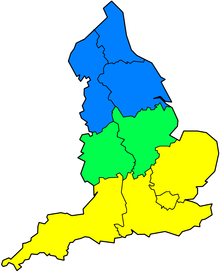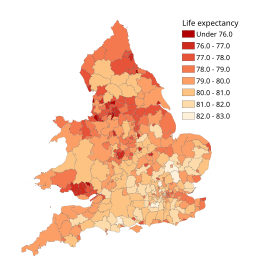Southern England
Southern England South of England | |
|---|---|
| Nickname(s): The South | |
 In this image, one definition of Southern England is illustrated as yellow. | |
| Sovereign state | United Kingdom |
| Country | England |
| 10 largest Settlements in order of population | .mw-parser-output .nobold{font-weight:normal}
|
| Area | |
| • Total | 23,955 sq mi (62,042 km2) |
| Population (2011) | |
| • Total | 27,945,000 |
| • Density | 1,200/sq mi (450/km2) |
| • Urban | 22,806,000 |
| • Rural | 5,139,000 |
| Demonym(s) | Southerner |
| Time zone | GMT (UTC) |
| • Summer (DST) | UTC+1 (BST) |
Southern England, or the South of England, also known as the South, refers roughly to the southern counties of England. The extent of this area can take a number of different interpretations depending on the context, including geographical, cultural, political and economic.
Geographically, the extent of the south of England may vary from the southern quarter (below the M4/Northern M25), via one-third of the country (excluding central England), to the southern half, bordering northern England. The South is often considered a principal cultural area of England, along with the Midlands and Northern England. Many consider the area to have a distinct identity from the rest of England, however without universal agreement on what cultural, political, and economic characteristics of the South are.
For statistical purposes, Southern England is divided into four regions: South West England, South East England, London, and the East of England. Combined, these have a total area of 62,042 square kilometres (23,955 sq mi), and a population of 28 million.
Contents
1 People
1.1 Health
2 Sport
3 Divisions
4 See also
5 References
People
People often apply the terms "southern" and "south" loosely, without deeper consideration of the geographical identities of Southern England. This can cause confusion over the depth of affiliation between its areas. As in much of the rest of England, people tend to have a deeper affiliation to their county or city. Thus, residents of Essex are unlikely to feel much affinity with people in Oxfordshire. Similarly, there is a strong distinction between natives of the south-west and south-east. The broadcaster Stuart Maconie has noted that culturally "there's a bottom half of England [...] but there isn't a south in the same way that there's a north".[1]
Health

Life expectancy at birth in England and Wales 2012 to 2014. Lighter colours indicate longer life expectancy.
One major manifestation of the North–South divide is in health and life expectancy statistics.[2] All three Northern England statistical regions have lower than average life expectancies and higher than average rates of cancer, circulatory disease and respiratory disease.[3][4] The South of England has a higher life expectancy than the North, however, regional differences do seem to be slowly narrowing: between 1991–1993 and 2012–2014, life expectancy in the North East increased by 6.0 years and in the North West by 5.8 years, the fastest increase in any region outside London, and the gap between life expectancy in the North East and South East is now 2.5 years, down from 2.9 in 1993.[4]
Sport
The sport of rugby experienced a schism in 1895 with many teams based in Yorkshire, Lancashire and surrounding areas breaking from the Rugby Football Union and forming their own League. The disagreement that led to the split was over the issue of professional payments, and "broken time" or injury payments. There is a perception that league is the code of rugby played in the north, whilst union is the code played in the south.
Divisions
In most definitions, Southern England includes all the counties on/near the English Channel. In terms of the current ceremonial counties:
- Bristol
- Cornwall
- Devon
- Dorset
- Hampshire
- Isle of Wight
- Oxfordshire
- West Sussex
- East Sussex
- Kent
- Somerset
- Wiltshire
- Berkshire
- Gloucestershire
- Surrey
- Greater London
- Hertfordshire
Despite the general acceptance of these counties as Southern, those that comprise the West Country are occasionally considered mutually exclusive to Southern England.
The exact northern extent varies and as with most geographical regions, people sometimes debate the boundaries. In the west, Southern England is generally taken to include Gloucestershire and Oxfordshire; in central Southern England, the counties of Bedfordshire, Buckinghamshire and Hertfordshire; to the east, Essex and the counties of East Anglia (Cambridgeshire, Norfolk and Suffolk).
Despite these definitions, the northern boundary is generally taken to correspond to an imaginary line from the Severn Estuary to the Wash (or expressed in terms of towns, from Gloucester to King's Lynn).
See also
- Constitutional status of Cornwall
- European Parliament constituencies in the United Kingdom
- Home Counties
- North–South divide in England
- North–South divide in the United Kingdom
- Regions of England
- Subdivisions of England
References
^ Maconie, Stuart (2007). Pies and Prejudice: In Search of the North. Ebury Press. p. 1. ISBN 978-0-09-191022-8..mw-parser-output cite.citation{font-style:inherit}.mw-parser-output q{quotes:"""""""'""'"}.mw-parser-output code.cs1-code{color:inherit;background:inherit;border:inherit;padding:inherit}.mw-parser-output .cs1-lock-free a{background:url("//upload.wikimedia.org/wikipedia/commons/thumb/6/65/Lock-green.svg/9px-Lock-green.svg.png")no-repeat;background-position:right .1em center}.mw-parser-output .cs1-lock-limited a,.mw-parser-output .cs1-lock-registration a{background:url("//upload.wikimedia.org/wikipedia/commons/thumb/d/d6/Lock-gray-alt-2.svg/9px-Lock-gray-alt-2.svg.png")no-repeat;background-position:right .1em center}.mw-parser-output .cs1-lock-subscription a{background:url("//upload.wikimedia.org/wikipedia/commons/thumb/a/aa/Lock-red-alt-2.svg/9px-Lock-red-alt-2.svg.png")no-repeat;background-position:right .1em center}.mw-parser-output .cs1-subscription,.mw-parser-output .cs1-registration{color:#555}.mw-parser-output .cs1-subscription span,.mw-parser-output .cs1-registration span{border-bottom:1px dotted;cursor:help}.mw-parser-output .cs1-hidden-error{display:none;font-size:100%}.mw-parser-output .cs1-visible-error{font-size:100%}.mw-parser-output .cs1-subscription,.mw-parser-output .cs1-registration,.mw-parser-output .cs1-format{font-size:95%}.mw-parser-output .cs1-kern-left,.mw-parser-output .cs1-kern-wl-left{padding-left:0.2em}.mw-parser-output .cs1-kern-right,.mw-parser-output .cs1-kern-wl-right{padding-right:0.2em}
^ Kirk, Ashley (15 September 2015). "Life expectancy increases to 81 years old - but north-south divide remains". Daily Telegraph. Archived from the original on 15 March 2017. Retrieved 14 March 2017.
^ Ellis, Amy; Fry, Robert (2010). "Regional health inequalities in England" (PDF). Office for National Statistics. Archived from the original (PDF) on 5 January 2016. Retrieved 14 March 2017.
^ ab Olatunde, Olugbenga (4 November 2015). "Life Expectancy at Birth and at Age 65 by Local Areas in England and Wales: 2012 to 2014". Office of National Statistics. Archived from the original on 15 March 2017. Retrieved 14 March 2017.